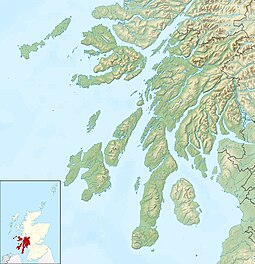Coll
| Gaelic name | Cola |
|---|---|
| Pronunciation | [kʰɔlˠ̪ə] |
| Meaning of name | Pre-Celtic and unclear |
| Location | |
|
Coll shown within Argyll and Bute
|
|
| OS grid reference | NM207584 |
| Coordinates | 56°38′N 6°33′W / 56.64°N 6.55°W |
| Physical geography | |
| Island group | Mull |
| Area | 7,685 hectares (29.7 sq mi) |
| Area rank | 18 |
| Highest elevation | Ben Hogh 106 metres (348 ft) |
| Administration | |
| Sovereign state | United Kingdom |
| Country | Scotland |
| Council area | Argyll and Bute |
| Demographics | |
| Population | 195 |
| Population rank | 32= |
| Population density | 2.5 people/km2 |
| Largest settlement |
Arinagour |
| Designated | 31 March 1995 |
| References | |
Arinagour
Coll (Scottish Gaelic: Cola) is an island located west of Mull in the Inner Hebrides of Scotland. Coll is known for its sandy beaches, which rise to form large sand dunes, for its corncrakes, and for Breacachadh Castle. It is in the council area of Argyll and Bute.
Coll is about 13 miles (20 km) long by 3 miles (5 km) wide and has a population of around 195. Coll's sandy beaches rise to form large sand dunes. The highest point on Coll is Ben Hogh in the mid west of the island, a ridge with two tops running NW/SE, which rises initially to a height of 104 metres (341 ft) with a triangulation pillar, and to 106 metres (348 ft) 450 metres (492 yd) to the southeast.
Arinagour (Scottish Gaelic: Àirigh nan Gobhar), is the main settlement on the island located at the head of Loch Eatharna, on the east coast. Other inhabited locations include:
Coll is sometimes derived from Gaelic coll, 'hazel'. However, this does not match the early recorded forms of the name. The name of Coll is given as Colosus in the Life of St Columba by Adamnán, the seventh century abbot of Iona. As /s/ between vowels had been lost in Celtic before Adamnán's time, Watson suggests that Colosus may represent a pre-Celtic name.Richard Coates has proposed that the name may be related to Greek kolossós and may have referred to a humanoid standing stone located on the island, like those still seen on North Uist and Lewis. As Kolossós is not originally a Greek word, Coates suggests that the name could have been given to Coll at a time when the kolossói of Mediterranean culture were well-known, or named "by speakers of a language in which the ancestor of the word was the native term." In Icelandic, the word kollur (Old Norse: kollr, Norwegian: koll or kolle) means "a rounded protrusion, such as a rounded mountaintop, or a tussock".
...
Wikipedia

